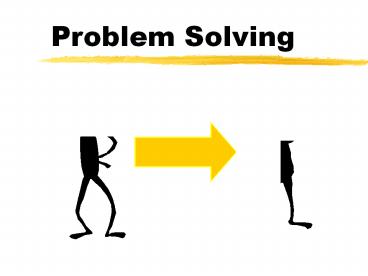Problem Solving - PowerPoint PPT Presentation
1 / 27
Title:
Problem Solving
Description:
Problem Solving Steps, con't. Clarify uncertainties ... Determine the importance of, time and effort devoted to the problem. How to identify objectives ... – PowerPoint PPT presentation
Number of Views:134
Avg rating:3.0/5.0
Title: Problem Solving
1
Problem Solving
2
Objectives
- Learn how to state and clarify a problem
- Develop a procedure for problem solving
- Learn the traps
- in problem solving
3
Whats typical?
Self-Doubt
Over Confidence
Procrastination
Flip-flops
Desperation!
WRONG!
4
Six Criteria for Effective Decisions
- Focuses on what is important
- Logical and consistent
- Acknowledges objective and subjective factors,
blends analytical and intuitive thinking - Does not gather too much information
- Tries to reach consensus
- Straightforward, reliable, easy to use, flexible
5
Problem Solving Model
P OACT
roblem
bjectives
lternatives
onsequences
radeoffs
6
Additional Factors
- Risk
- Uncertainty
- Linked decisions
7
Problem Solving Steps
- State the problem carefully
- Acknowledge complexities
- Avoid assumptions and prejudices
- Specify the objectives
- Create imaginative alternatives
- Understand the consequences of the alternative
- Grapple with your tradeoffscont
8
Problem Solving Steps, cont
- Clarify uncertainties
- Think about your risk tolerance and the risks of
each alternative - Consider linked decisions
- Each alternative opens or closes future options
9
Whats the best solution?
A good solution to a well-posed problem.
Is a almost always a smarter choice than..
An excellent solution to a poorly posed problem
10
Define the Problem
- What triggers the problem?
- State the problem
- Question the constraints of the problem
- statement
- Identify the essential elements
- How does this impact other decisions?
- What is the scope of the problem?
- Gain insights from others
- Restate problem, if necessary
11
What Objectives Do
- Help determine what information to seek
- Explain your choices to others
- Determine the importance of, time and effort
devoted to the problem
12
How to identify objectives
- Write down the concerns you hope to address
- Wish list
- Worst possible outcome
- Impact on others
- Insights from others
- Whats a good alternative but unfeasible?
- What is bad about the worst alternatives?
13
How to identify objectives
- Convert the concerns into succinct objectives
- Separate the ends from the means
- Clarify what you mean by each objective
- Test your objectives
14
Alternatives
- Use your objects and ask HOW?
- Challenge constraints to your alternatives
- Set high aspirations
- Think through your alternatives before consulting
others - Learn from past experience
- Then ask others for suggestions
15
How to generate alternatives
- Brainstorming
- Just list alternatives, dont evaluate
- Never stop looking for alternatives
- Look for win-win alternatives
- Stop when youve thought through alternatives
- One solution would satisfy you
- But still have a range of alternatives
16
Consequences
- List the consequences of each alternative
- Assess the future consequences of each
alternative - Create a free-form description of the
consequences - Eliminate any clearly inferior alternatives
- Organize descriptions of remaining alternatives
into a table .
17
Consequences
- Try to develop a common scale to measure
consequences - Use qualitative and quantitative data
- Use experts if necessary
- Use scales that reflect appropriate levels of
precision
18
Tradeoffs
- Eliminate alternatives clearly dominated by
others - Then swaps between alternatives using measures
- Value incremental improvements
- Make consistent tradeoffs
19
Uncertainties
- What are the key uncertainties?
- What are the possible outcomes of these
uncertainties? - What are the changes of the outcomes, given
these uncertainties? - What are the consequences of each outcome?.
20
Uncertainties
- Identify the key uncertainties
- Define the possible outcomes
- Assign chance of occurrence of each outcome
- Clarify consequences using quantitative and
qualitative measures - Create a decision tree
21
Risk Tolerance
- How much risk do you want to handle?
- How much are others affected by your decision?
- Quantify the risks, if possible
- Seek to lessen the risks but avoid foolish
optimism - Dont avoid making risky decisions just because
they are complex
22
How to lessen risk
- Seek risk reducing information
- Diversify the risk
- Hedge the risk
- Insure against the risk
23
Linked decisions
- Choose options that leave future flexibility
intact - Get timing right on decision tree
- Describe the consequences at the end points
24
Psychological Traps
- Working on the wrong problem
- Failing to identify key objectives
- Failing to develop a range of good, creative
alternatives - Overlooking crucial consequences of your
alternatives - Giving inadequate thought to tradeoffs
- Disregarding uncertainty.
25
Traps, cont
- Failing to account for risk intolerance
- Failing to plan ahead when decisions are linked
over time...
So, tell me some specifics on these traps...
26
Common Traps
- Anchoring trap
- Status Quo Trap
- Sunk Cost Trap
- Confirming Evidence Trap
- Framing Trap
- Overconfidence Trap
- Recallability Trap
- Base Rate Trap
- Prudence Trap
- Random Events
27
Review
- A model for problem solving
- The actions in each of the steps
- Common Traps in problem solving































